The Top 7 Resonator Guitars – Finding the Best Brands and Models on the Market
We may also earn commissions on purchases from other retail websites.
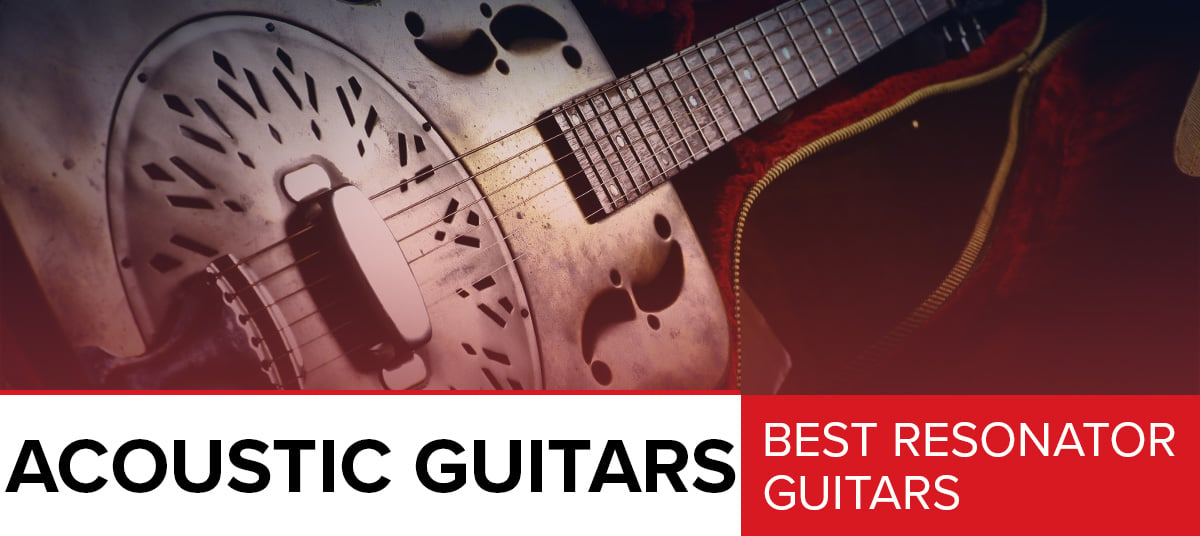
What’s that hauntingly beautiful metallic sound? That, my friend, is the sound of a resonator. However, whether you are an experienced player or completely new to this genre, there’s more to resonators than just ‘an acoustic guitar with a cone’.Last Updated: February 22, 2019
We made a few amendments to this chart to reflect the changes in the market recently. We added the eye-catching Dean Chrome G Roundneck, while we also saw the return of two old favorites in the Gretsch G9210 Boxcar and the Rogue Classic Spider Resonator.
Which is why our chart of the top resonators on the market today (under $1,000) is so varied. We have a good mix of spiders and biscuits, roundnecks and squarenecks, and wooden and metal bodies.
Not sure what all this means? Don’t worry – stay tuned until after the chart, where we will guide you through some of the fundamentals of this exciting guitar style.
Note: In the chart below, while we may review either a squareneck or roundneck model, other variations probably exist. So, if you like the sound of one guitar but are disappointed to see it’s squareneck, look around because you can probably find a roundneck version offering the same specs – and vice versa.
Top 7 Resonator Guitars:
| Image | Acoustic Guitar / Rating | Summary | Check Price |
|---|---|---|---|
+ -  | Danelectro ’59 Acoustic-Electric Resonator Total of 4.80/5 | An awesome retro resonator you can plug in. | |
+ - 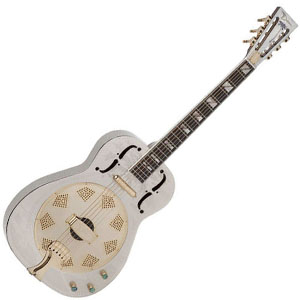 | Dean Chrome G Roundneck Total of 4.55/5 | A stunning chrome/gold roundneck resonator from Dean. | |
+ -  | Gretsch G9220 Bobtail Total of 4.78/5 | A 1920s-inspired roundneck resonator with solid tone. | |
+ -  | Gretsch G9210 Boxcar Squareneck Total of 4.78/5 | Gretsch combines style, sound and value with this 30s-inspired squareneck. | |
+ -  | Dean Thinbody Cutaway Resonator Total of 4.75/5 | Dean’s slim electro-acoustic resonator features great playability and versatility. | |
+ -  | Rogue Classic Spider Resonator Total of 4.57/5 | No frills on this basic but stylish resonator from Rogue. | |
+ -  | Pyle PGA48BR Total of 4.47/5 | A basic package from Pyle offering convenience and good value. |
Danelectro ’59 Acoustic-Electric Resonator
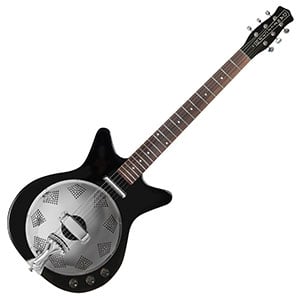
| Body And Neck: |  |
| Hardware: |  |
| Sound: |  |
| Value: |  |
If you’re looking for a versatile blues resonator that allows you to plug in and bring the house down with tone (all with a price tag that doesn’t make your eyes water), then Danelectro’s awesome ’59 Acoustic-Electric resonator will definitely appeal.
Using the brand’s timeless double-cutaway Shorthorn body shape and a sleek maple neck, the ’59 shows off great playability for all styles. It comes loaded with two pickups – one visible ’56 Lipstick pickup, and Schatten piezo that sits under the coverplate inside the biscuit cone.
The tone is just perfect for slide and fingerpicking, Mississippi Delta blues and bluegrass, and everything in between. There’s more on the Danelectro ’59 resonator in the full review.
Dean Chrome G Roundneck

| Body And Neck: |  |
| Hardware: |  |
| Sound: |  |
| Value: |  |
Shield your eyes – the Chrome G Roundneck is one vibrant resonator from a brand that knows how to design an eye-catching guitar!
This is a midrange biscuit-bridge electro-acoustic, with a non-cutaway body made from polished chrome, featuring beautiful golden hardware. There are some additional visual treats, such as the ornate headstock and pearl/abalone split block inlays on the fretboard.
In addition to looking the part, it is fitted with two blendable pickups that amplify the naturally twangy, raw tone quite well – even if the piezo pickup is a little weak. There’s more on the strengths and weaknesses of this beautiful resonator in our full review of the Dean Chrome G.
Gretsch G9220 Bobtail
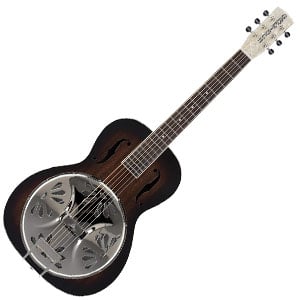
| Body And Neck: |  |
| Hardware: |  |
| Sound: |  |
| Value: |  |
With the G9220 Bobtail, the masters of American vintage Gretsch deliver a real retro treat that’s ready for the stage. This small-bodied 19-fret, roundneck resonator is made entirely of laminated mahogany, with several vintage appointments that give it a timeless look – the dark sunburst finish and extroverted pearloid headstock in particular.
The hardware combines to give a great sound, with Gretsch’s Ampli-Sonic hand-spun spider cone and bridge producing a loud resonator twang, which somehow remains refined.
As we highlight in the full review of the G9220 Bobtail, it also features a Fishman Nashville Resophonic pickup which means plugging in is a simple task – and sounds great when doing it!
Gretsch G9210 Boxcar Squareneck
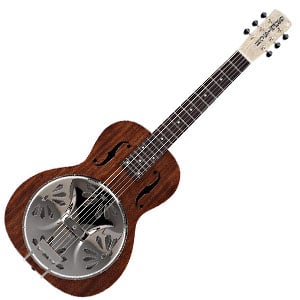
| Body And Neck: |  |
| Hardware: |  |
| Sound: |  |
| Value: |  |
While similar to the Bobtail, Gretsch’s G9210 Boxcar is a slightly more affordable resonator, with a squareneck design that’s ideal for both experienced and beginner lap steel players.
As we highlight in the full review of the G9210, the body is made of laminated mahogany and features a sturdy mahogany neck, with 19 frets and a tall bone nut. Ultimately, it’s a simple guitar, although the eye-catching aged pearloid Gretsch headstock adds a little flair.
The sound is also excellent for the price, with good warmth, ample sustain, and plenty of projection, which comes courtesy of the aluminum resonator cone and spider bridge. A great resonator to add to the shortlist, whatever your budget.
Dean Thinbody Cutaway Resonator
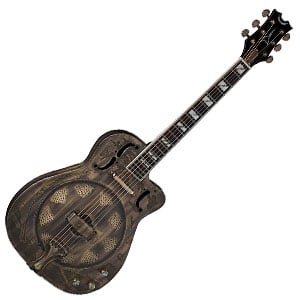
| Body And Neck: |  |
| Hardware: |  |
| Sound: |  |
| Value: |  |
With this Thinbody Cutaway, Dean have crafted a very stylish and performance-oriented roundneck resonator, with great versatility. The slim single-cutaway body is made from engraved brass-plated iron, which gives it a cool – almost steampunk – style.
The mahogany neck is excellent to play, especially for those more used to an electric guitar, with a low action and familiar C shape, as well as a rosewood fretboard. Along with a classic biscuit resonator cone and bridge, this thinbody is loaded with two pickups – piezo and lipstick – and controlled by individual volume controls and a blend control, leading to a versatile sound with lots of character.
Make sure to check out our complete review of the Dean Thinbody Cutaway Resonator for all the details.
Rogue Classic Spider Resonator
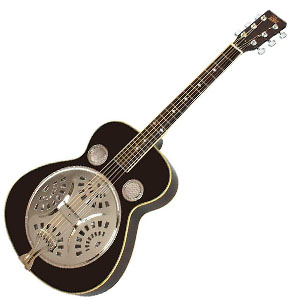
| Body And Neck: |  |
| Hardware: |  |
| Sound: |  |
| Value: |  |
From Rogue – a brand best known for their affordable entry-level guitars – this Classic Spider roundneck resonator is a great choice for both beginners and experienced guitarists on a budget.
With a sleek black finish and cream binding, it’s an elegant-looking instrument that’s comfortable to play sitting on the knee (just like a regular acoustic guitar), and shows good materials for the price. There’s laminated spruce on the top, while the back and sides are made from a laminated mahogany.
With a 10.5” spun aluminum resonator cone and spider bridge, this guitar offers a traditional twangy tone and lengthy sustain. You can check out the full review of Rogue’s Classic Spider for more details.
Pyle PGA48BR
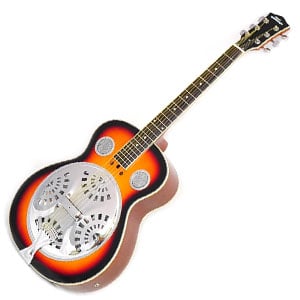
| Body And Neck: |  |
| Hardware: |  |
| Sound: |  |
| Value: |  |
Complete beginner? On a strict budget? Pyle’s sub-$200 PGA48BR electro-acoustic resonator is a decent choice. While it lacks any sniff of premium – and you will probably find a few rough spots – the body is pretty good, with a laminated spruce top, and mahogany back and sides, all finished in a natural sunburst.
There’s an aluminum resonator cone, with a spider bridge and rosewood saddle, which offers the classic twangy sound, although it leaves a little to be desired tonally. Still, the electronics are versatile with a pickup and preamp offering 3-band EQ, for simple amplification.
Throw in a basic but convenient package of accessories and, for the price, this is a very good purchase for any beginner, as we highlight in the PGA48BR’s full review.
While the chart above is by no means a comprehensive list, it certainly provides a good snapshot of what’s popular in today’s resonator market.
Earlier we promised to take a look at some of the different body, neck and cone styles on offer, so let’s start checking these out.
Square or Round Neck?
‘Really… I have a choice?’ – You most certainly do!
Experienced players will know the differences, but it may be confusing to beginners or guitarists coming from an acoustic/electric guitar background.
In short, resonators either come as a roundneck or squareneck (sometimes called a flatneck) model – both are very different, and what you end up with will determine how you actually hold and play the guitar:
Squareneck
While there are no set rules, if you’re planning to play bluegrass, Hawaiian or country, or want to replicate the sweet sounds of Jerry Douglas or Mike Auldridge, you’ll want a squareneck resonator.
This is because they are held on the lap, with the fretboard facing up, and played like a lap steel guitar with a slide or bar. In fact, squarenecks are almost impossible to play in the conventional Spanish / on the knee style.
The main characteristics of a squareneck resonator are that it has a neck which is chunky, wide, and squared off at the edges – not comfortable to hold, but perfect for resting on a lap. The nut is set much higher than a regular guitar, making conventional fretting impossible. Therefore, it’s only really played with a bar or a slide – the frets are just there as a guide, and aren’t used to make a sound.
While squarenecks are excellent if you know how to play one, if you’re a beginner or planning to play as you would a standard guitar, then a roundneck is probably better for you.
Roundneck
A roundneck resonator is what the majority of guitarists will be used to playing – a guitar with a curved (i.e. C or D shape) neck, fretted as you would a conventional guitar.
In fact, there’s little difference in playing a roundneck resonator to a regular acoustic guitar. You can play it with a slide, but it’s equally effective being strummed, flat-picked or played fingerstyle. This versatility is one of the reasons why a roundneck resonator is favored for the blues genre.
You can actually turn a roundneck into a squareneck model by using a nut extender, which is a lot cheaper than having to purchase two different resonators. However, switching between the height is not an easy process, and can put a lot of stress and strain on the neck, not to mention the time it takes you to do it.
Biscuit, Spider or Tricone?
Just when you’ve settled on a round or square neck, another option is vying for your attention. This time, it’s the resonator style – do you go for a biscuit, spider or tricone?
Each has their own individual tonal characteristics, although the exact sound you get will depend on several factors including the body woods, quality of the instrument, and manufacturer – one brand’s spider may sound quite different to another brand’s. Let’s take a quick look at the general differences:
Tricone
Introduced in 1927, the tricone is the oldest resonator style, and comprises three small aluminum cones, connected by an aluminum T-shaped bridge. The tricone sound is one of beautiful complexities and long-lasting sustain, with great projection. However, as there are three cones and the guitars take more time and effort to produce, a tricone resonator tends to cost much more than the other two variations.
Spider
The spider-bridge resonator is a single downward-facing cone, sitting in the guitar like a speaker cone. Fixed to the cone is an eight-legged aluminum framed bridge (hence the name), with a saddle at the top. Spiders tend to offer great sustain and a more nasal tone – perfect for country and bluegrass slide styles in particular. It’s worth noting that, due to the regular speaker shape of the cone, the sound is projected directly outwards instead of into the body.
Biscuit
The biscuit-bridge resonator is the simplest design. It makes use of a single large upward-facing cone, with a wooden disc (aka, the biscuit) at the peak. The biscuit offers that great fundamental resonator tone, even if it is seen as less refined. They tend to offer simpler tones than the other two, but provide lots of bite – a real classic in terms getting that twangy, gritty sound.
Wood or Metal?
Another choice you have to make is whether to go for a wooden or metal body. Unlike your regular acoustic guitar, the body material doesn’t play as big a tonal role, as the majority of sound is produced by the resonator cone.
What style body you go for will depend on your tonal preferences, but generally a wooden body will offer a warmer, fuller tone while the metal body will, obviously, sound more metallic and brittle, with a louder overall projection. What you choose will be down to your budget and tonal preferences.
One thing to note is that, while on acoustic guitars solid woods are desirable, on a resonator, even the most expensive models will use laminates. This is because laminates are more sturdy, and the sturdier the body the better the projection. The tonal benefits of using solid wood on a resonator are negligible, so much so that manufacturers only tend to use solid wood on a resonator if it will offer superior aesthetics.
Do I Need an Electro-Acoustic Resonator?
Resonators were first created in the 1920s for guitarists wanting a louder acoustic experience, giving them the ability to cut through the mix and be heard over other instruments such as percussion and horns.
In general, a resonator is much louder than your standard acoustic. So, if you are playing on the front porch or having an impromptu jam, it’s unlikely you’ll need electronics to boost the volume of your resonator.
However, if you are performing on stage, then you may want to consider a resonator with a pickup. Some excellent electro-acoustic models are available, some with piezo pickups, some with lipstick/single-coils, and others with a mix of both.
These tend to be controlled with either a preamp control panel (as you may see on conventional acoustic guitars) with EQ controls, or other guitars with rotary control knobs (volume and blend), similar to what you’d find on an electric guitar.
As a rule of thumb, if you are a beginner – or not planning to perform to more than a handful of people – then leave the electronics. You can get a better guitar for your cash.
Should I Buy Used or New?
It’s a good question, because shopping used can open up a whole world of new options for you, whatever your budget.
For example, with $500 in your pocket, you could end up with a resonator worth closer to $1,000 if you are willing to buy used.
The obvious problem with buying used is that you don’t know what has happened to the guitar in its previous life. Has it been dropped or damaged? Has the cone been replaced or tinkered with? Just like an electric guitar, there’s a lot that can go wrong ‘under the hood’ with a resonator.
If you are buying used, be sure to use a reputable online store or a respected guitar store. Ideally you can inspect and try out the resonator before you purchase it. If not, buy from somewhere with a clearly outlined returns policy.
The Final Word
When compared to classical guitars, acoustic guitars and even electric guitars, resonators can seem complicated, with so many variations, styles and sounds. However, after you grasp the basics, it all becomes a little clearer.
Whether you are an experienced squareneck spider player or a beginner roundneck biscuit enthusiast, we hope our chart and guide has given you a bit of inspiration. When you’ve settled on a shortlist, make sure to read plenty of reviews, watch videos, and – if you can – try out your chosen models before settling on something that will hopefully last you for years and years of happy playing.
Good luck with the search for your ideal resonator!




Lexiplex says
Intermediate guitar player seeking resonator for fun. Thank you so much for this information! Very thorough, very helpful….
Brad Davis says
Great article. Curious which of these models, if any, are offered lefty as stock?…no added charge.
Thanks again for the very informative article.